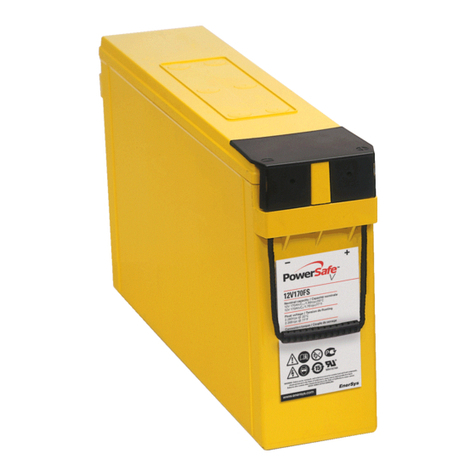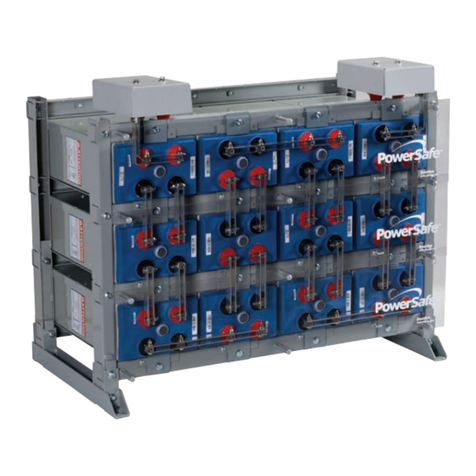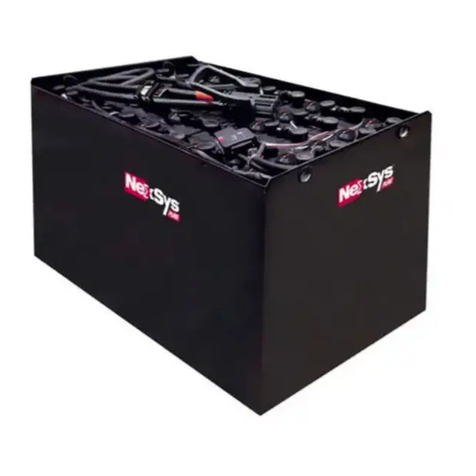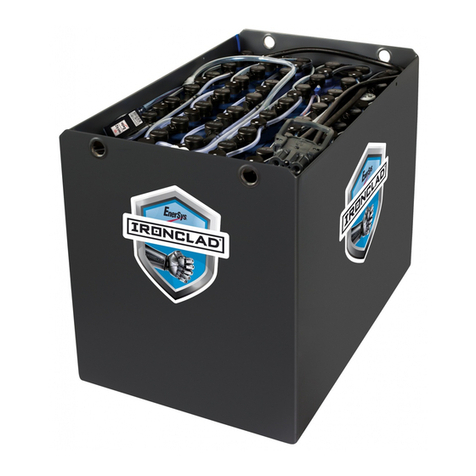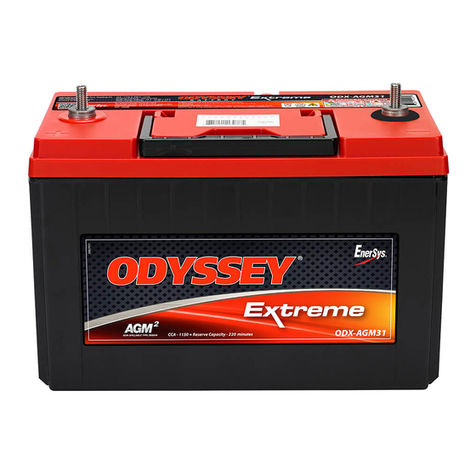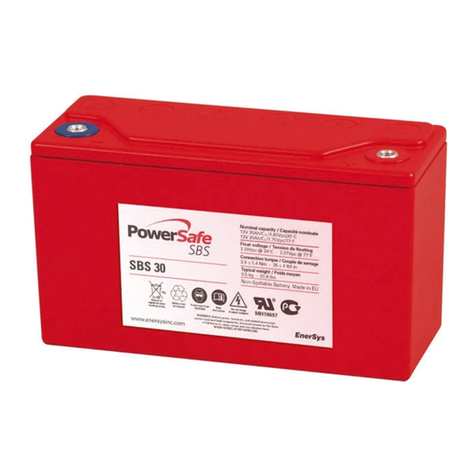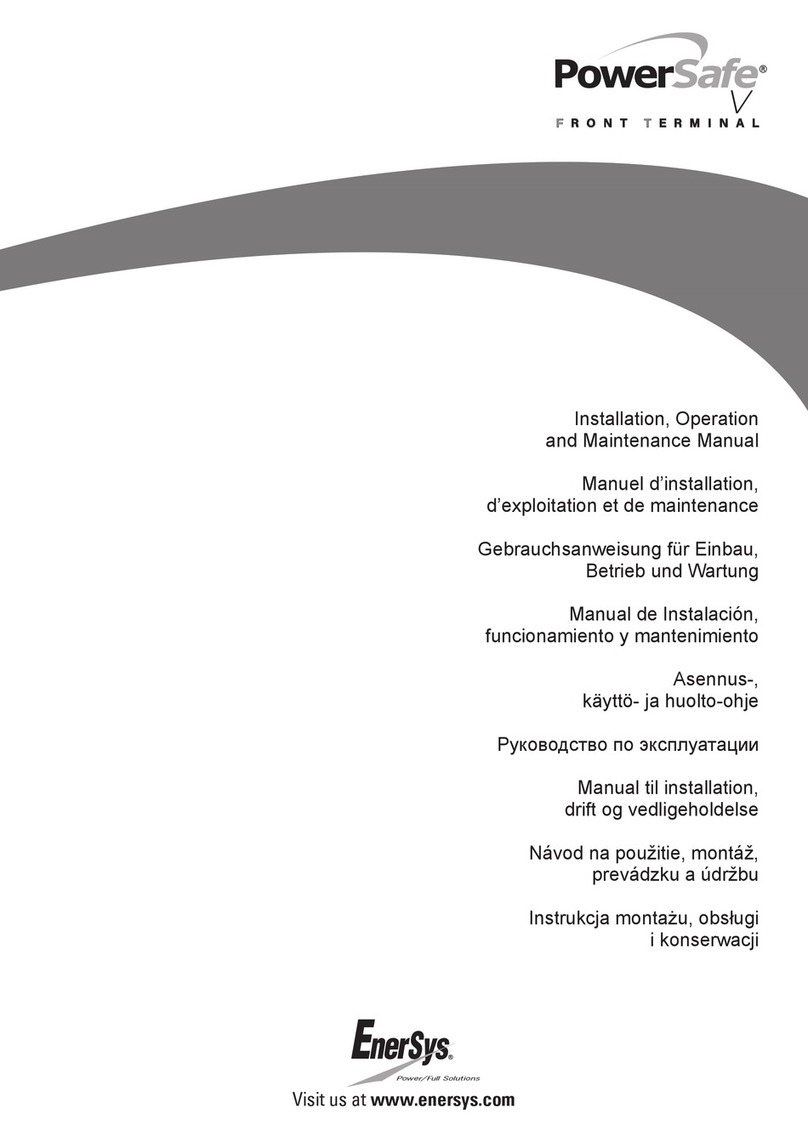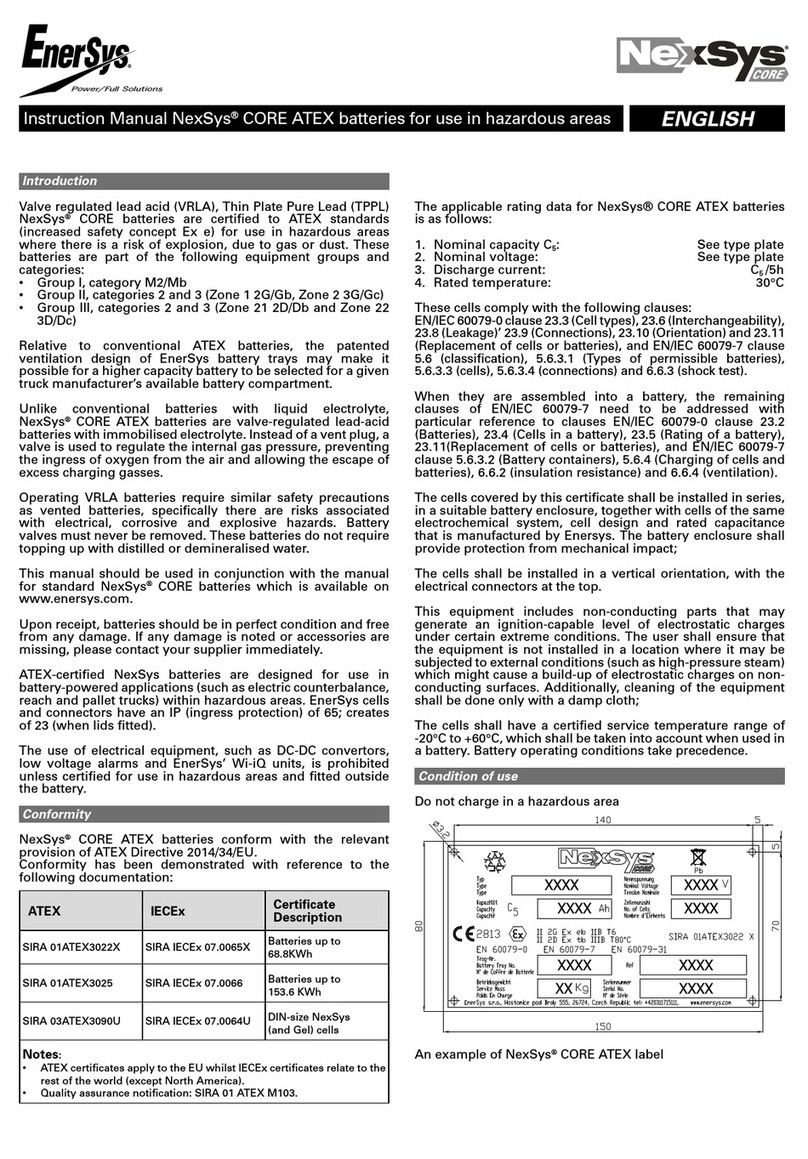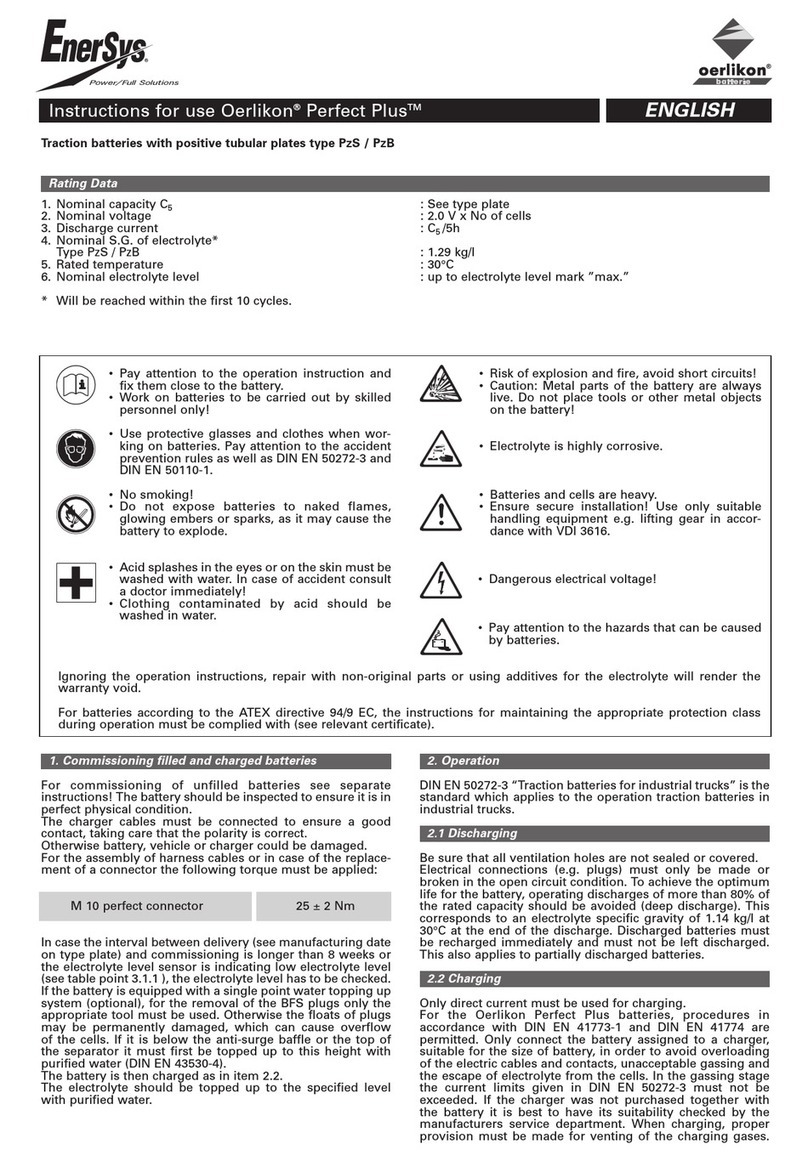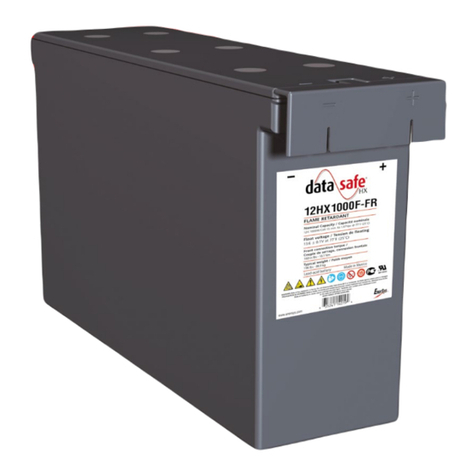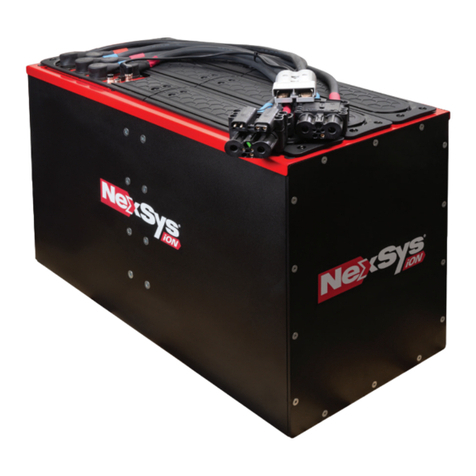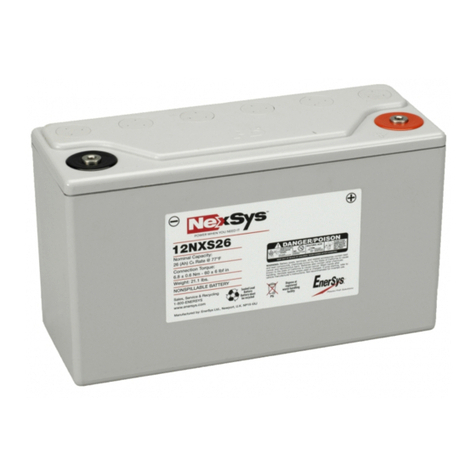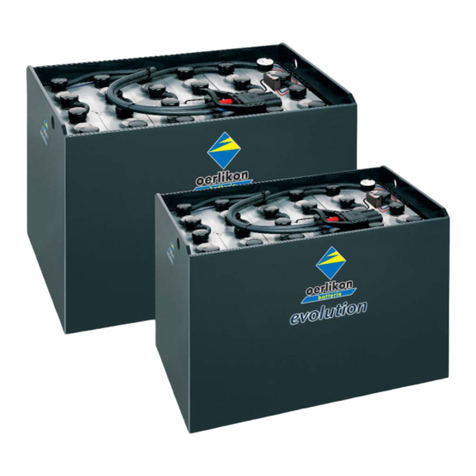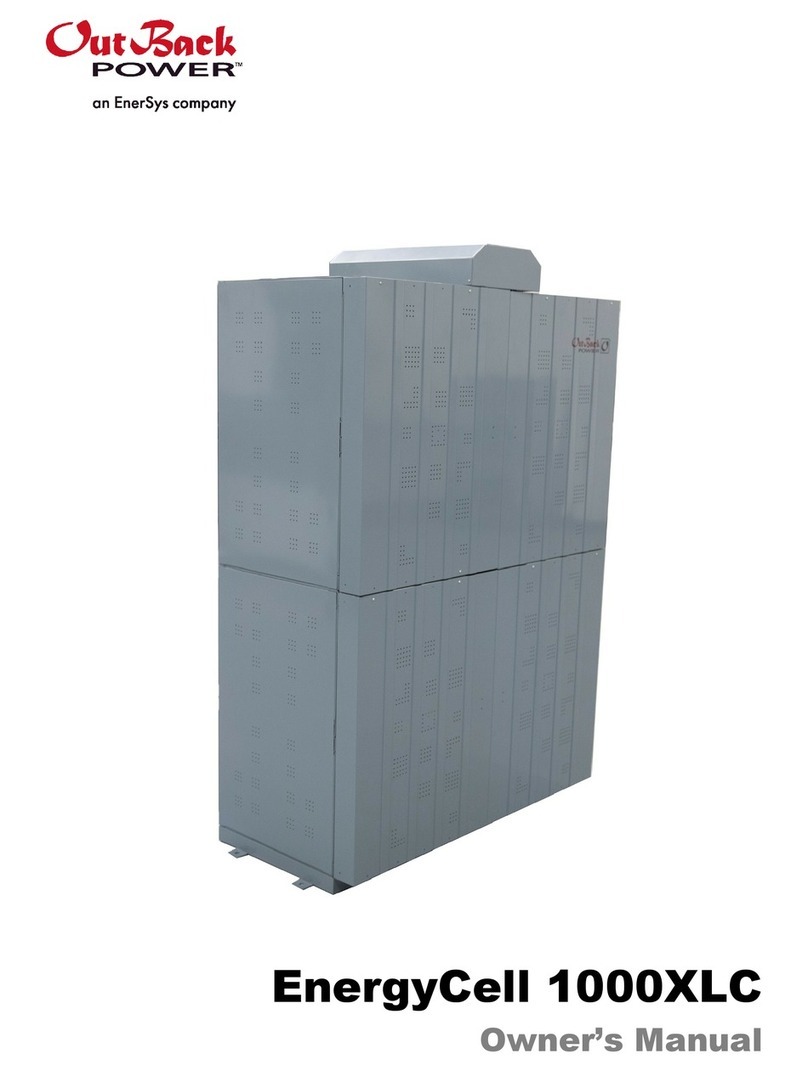
3
Publication No: EN-VARTA-NB-IS-001 - September 2006
www.enersys.com
Battery delivered filled and discharged / the battery should be
charged for 15 hours at the rated charging current 0.2 lt A.
Approximately 4 hours after the end of charging the electrolyte level
should be adjusted to the upper electrolyte level marked “MAX” by
using distilled or deionized water in accordance with IEC 60993. For
cells with steel cases, the electrolyte level should be adjusted to the
maximum level according to the “Instruction for the control of
electrolyte level”. During the charge the electrolyte level and
temperature should be observed (see point 5.4). The electrolyte
level should never fall below the “MIN” mark.
Battery delivered filled and charged and stored for more than
12 months / the battery should be charged for 15 hours at the rated
charging current 0.2 lt A. Approximately 4 hours after the end of
charging the electrolyte level should be adjusted to the upper
electrolyte level marked “MAX” by using distilled or deionized
water in accordance with IEC 60993. For cells with steel cases, the
electrolyte level should be adjusted to the maximum level according
to the “Instruction for the control of electrolyte level”. During the
charge the electrolyte level and temperature should be observed
(see point 5.4). The electrolyte level should never fall below the
“MIN” mark.
Battery delivered filled and charged / a 5 hour charge at the rated
charging current 0.2 lt A must be carried out before setting the
battery into service. Approximately 4 hours after the end of charging
the electrolyte level should be adjusted to the upper electrolyte level
marked “MAX” by using distilled or deionized water in accordance
with IEC 60993. For cells with steel cases, the electrolyte level should
be adjusted to the maximum level according to the “Instruction for
the control of electrolyte level”. During the charge the electrolyte
level and temperature should be observed (see point 5.4). The
electrolyte level should never fall below the “MIN” mark.
3.5.2 Commissioning with constant voltage
If the charger´s maximum voltage setting is too low to supply
constant current charging, divide the battery into two parts that will
be charged individually.
Battery delivered unfilled and discharged / after a period of 5 hours
from filling the electrolyte, the battery should be charged for 30
hours at the rated charging voltage of 1.65 V/cell. The current limit
should be 0.2 lt A maximum. Approximately 4 hours after the end of
charging the electrolyte level should be adjusted to the upper
electrolyte level marked “MAX” by using only genuine electrolyte.
For cells with steel cases, the electrolyte level should be adjusted to
the maximum level according to the “Instruction for the control of
electrolyte level”. During the charge the electrolyte level and
temperature should be observed (see point 5.4). The electrolyte
level should never fall below the “MIN” mark.
Battery delivered filled and discharged / the battery should be
charged for 30 hours at the rated charging voltage of 1.65 V/cell. The
current limit should be 0.2 lt A maximum. Approximately 4 hours
after the end of charging the electrolyte level should be adjusted to
the upper electrolyte level marked “MAX” by using distilled or
deionized water in accordance with IEC 60993. For cells with steel
cases, the electrolyte level should be adjusted to the maximum level
according to the “Instruction for the control of electrolyte level”.
During the charge the electrolyte level and temperature should be
observed (see point 5.4). The electrolyte level should never fall
below the “MIN” mark.
Battery delivered filled and charged and stored for more than 12
months / the battery should be charged for 30 hours at the rated
charging voltage of 1.65 V/cell. The current limit should be 0.2 lt A
maximum. Approximately 4 hours after the end of charging the
electrolyte level should be adjusted to the upper electrolyte level
marked “MAX” by using distilled or deionized water in accordance
with IEC 60993. For cells with steel cases, the electrolyte level should
be adjusted to the maximum level according to the “Instruction for
the control of electrolyte level”. During the charge the electrolyte
level and temperature should be observed (see point 5.4). The
electrolyte level should never fall below the “MIN” mark.
Battery delivered filled and charged / a 10 hour charge at the rated
charging voltage of 1.65 V/cell must be carried out before putting the
battery into operation. The current limit should be 0.2 lt A maximum.
Approximately 4 hours after the end of charging the electrolyte level
should be adjusted to the upper electrolyte level marked “MAX” by
using distilled or deionized water in accordance with IEC 60993. For
cells with steel cases, the electrolyte level should be adjusted to the
maximum level according to the “Instruction for the control of
electrolyte level”. During the charge the electrolyte level and
temperature should be observed (see point 5.4). The electrolyte
level should never fall below the “MIN” mark.
4. Charging in operation
4.1 Continuous battery power supply (with occasional battery
discharge)
Recommended charging voltage for ambient temperatures + 20°C
to + 25°C
Do not remove the vent caps during float, boost charge and buffer
operation. The current limit should be 0.3 lt A maximum in general.
4.1.1 Two level charge
Floating: 1.40 - 1.42 V/cell Boost charge: 1.55 - 1.70 V/cell
A high voltage will increase the speed and efficiency of recharging
the battery.
4.1.2 Single level charge: 1.45 - 1.50 V/cell
4.2 Buffer operation: Where the load exceeds the charger rating.
1.45 - 1.55 V/cell
5. Periodic Maintenance
The battery must be kept clean using only water. Do not use a wire
brush or solvents of any kind. Vent caps can be rinsed in clean water
if necessary but must be dried before using them again.
Check regularly (approximately every 6 months) that all connectors,
nuts and screws are tightly fastened. Defective vent caps and seals
should be replaced. All metal parts of the battery should be
corrosion-protected by coating with a thin layer of anti-corrosion
grease. Do not coat any plastic part of the battery, for example cell
cases!
Check the charging voltage. If a battery is parallel connected it is
important that the recommended charging voltage remains
unchanged. The charging current in the strings should also be
checked to ensure it is equal. These checks have to be carried out
once a year. High water consumption of the battery is usually
caused by improper voltage setting of the charger.
5.1 Equalising charge
It is recommended to carry out an equalising charge once a year to
maintain capacity and to stabilise the voltage levels of the cells. The
equalising charge can be carried out for 15 hours at 0.2 lt A or with
the boost charging stage in conformity with the characteristic curve
of the available charging equipment. The electrolyte level must be
checked after an equalising charge.
In order to equalise the floating derating effect it is recommended to
charge the battery once a year for 15 hours at the rated charging
current 0.2 lt A. Then discharge the battery down to 1.0 V/cell and
charge again for 8 hours at the rated charging current 0.2 lt A.





